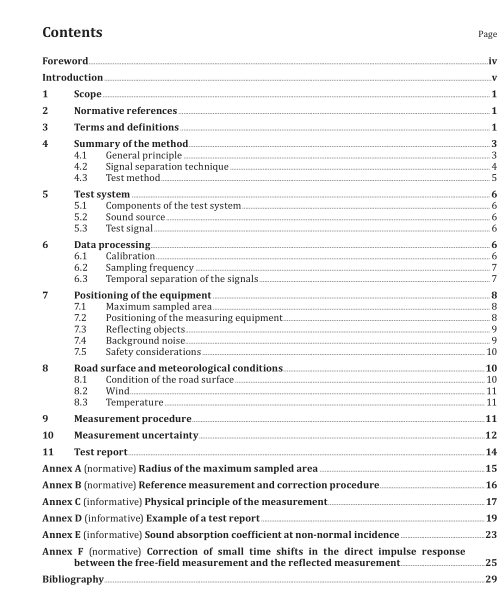ISO 13472-1:2022 pdf download.Acoustics — Measurement of sound absorption properties of road surfaces in situ — Part 1: Extended surface method
4.2 Signal separation technique
This document specifies how the sound source and the microphone shall be positioned over the surface under test and how the overall impulse response shall be measured. The overall impulse responses consist of a direct component, a component reflected from the surface under test and other parasitic reflections, see Figure 2 a).
The direct component and the reflected component from the surface under test shall be separated. This separation shall be done using the signal subtraction technique (seeFigure 2): the reflected component is extracted from the overall impulse response after having removed the direct component by subtraction of an identical signal [see Figures 2 c) and 2 d)]. This can be obtained by performing a free-field measurement using the same geometrical configuration of the loudspeaker and the microphone. In particular, their relative position shall be kept as constant as possible. The direct component is extracted from the free-field measurement [see Figure 2 b)].
NOTE This technique allows broadening of the time window, leading to a lower frequency limit of the working frequency range, without having very long distances between loudspeaker, microphone and surface under test. Furthermore, the microphone can be placed closer to the road surface so as to improve the S/N ratio and decrease the effect of geometrical spreading. For source and microphone distances from the plane of reference for the road surface, this document requires the following values: d s m =1 25 , and d m m =0 25 , (see Figure 1).
These distances shall be kept constant during the averaging process (±0,01 m). The direct impulse response has to be exactly known in shape, amplitude and time delay. This is obtained by performing a free-field measurement using the same geometrical configuration of the loudspeaker and the microphone. In particular, the distance between them shall be kept strictly constant. This requirement can be met by using a fixed and stable connection between the source and the microphone. If the direct impulse response has been subjected to a small time shift between the free field measurement and the reflection measurement, this shall be corrected (see Annex F).
In order to avoid temperature differences between the free field measurement and the measurement on the surface under test, it is recommended to perform the two measurements within a short time
(<10 min).
4.3 Test method
The measurement shall take place in an essentially free field, i.e. a field free from reflections coming from objects other than the surface under test. However, the use of a time window cancels out reflections arriving after a certain time period, and thus originating from locations further away than a certain distance (see Clause 7).
In order to minimize the effects of the background noise and meteorological variations, a number of impulse responses shall be acquired and averaged to get the minimum S/N ratio as specified in 7.4.
Often, very small sound absorption values are measured in the low-frequency range. Accurate values in this range are very difficult to obtain. Small variations in the assessment of the sound pressure levels of both the direct signal and the reflected signal can induce high inaccuracies in the sound absorption values. In order to avoid this problem, and in order to improve the accuracy of the method, a reference measurement on a totally reflective surface shall be performed (see Annex B).
5 Test system
5.1 Components of the test system
The test equipment shall comprise an electronic signal generator, a power amplifier and a loudspeaker,a microphone with amplifier and a signal analyser capable of performing cross-correlation and transformations between the time and the frequency domains.
A sketch of the essential components of the measuring system is shown in Figure 1.
The complete measuring system shall meet the requirements of at least a type 2 instrument in accordance with IEC 61672-1. For the purposes of this document, the measurement frequency range is displayed in one-third-octave bands, from 250 Hz to 4 kHz.ISO 13472-1 pdf download.ISO 13472-1 pdf download
